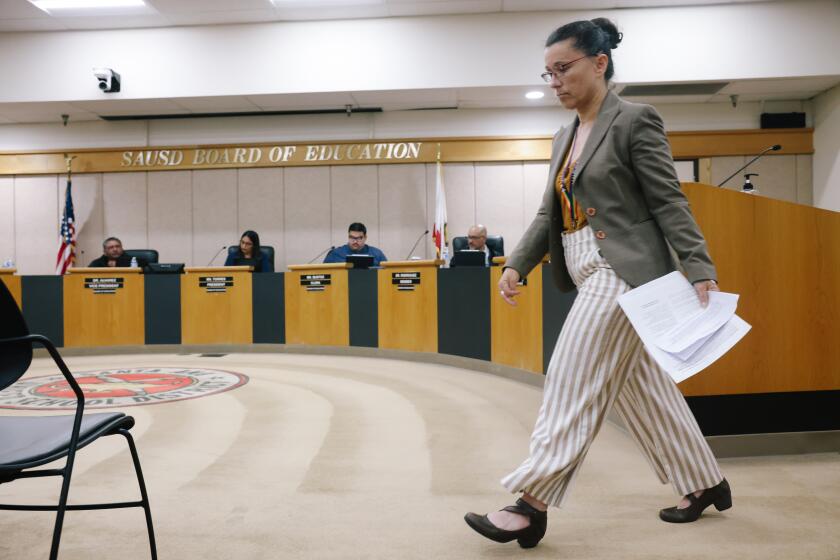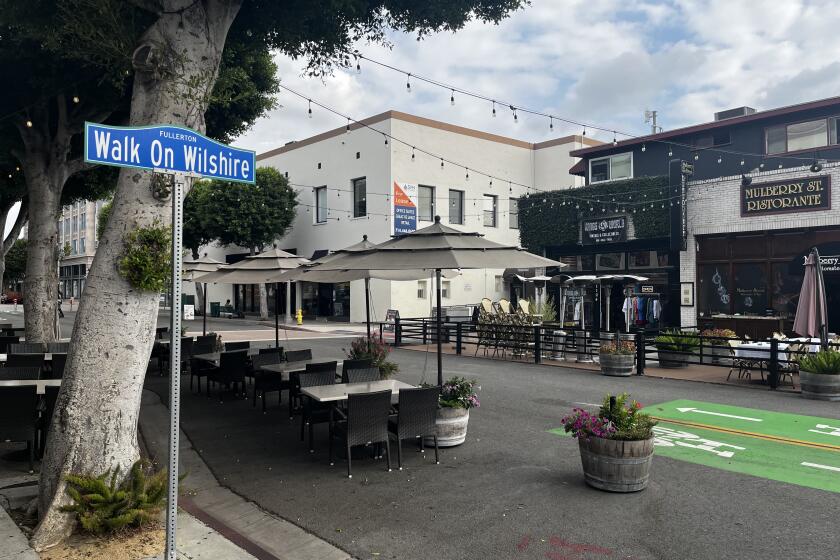Origin stories: Artists examine and protect their past at OCCCA

- Share via
A persimmon tree stands in the backyard of Maribel Nuño Navarro’s parents’ home. The tree is one of the symbols Navarro uses to explore her heritage in a piece titled “El Persimo (the Persimmon Tree)” featured in the Orange County Center for Contemporary Art’s exhibition, “Original Sources.”
“It is a portrait of how I envision heritage looking, conceptually,” said Navarro, who co-curated the show with fellow artist and friend Juan Gomez.
Multiple images are layered into the graphite work; ancient ruins blending seamlessly into plants, animals and the persimmon tree make it difficult to see where one image ends and another begins.
Opening Saturday and running through Nov. 30, “Original Sources” features 11 artists examining ancestral influences and the ambiguity of time. Like Navarro’s work, a shared history in a family can trace so far back it can be hard to know exactly where it began or when it evolved to give way to the present.
The diverse work of Navarro and Gomez along with Chris Maya, Christopher A. Velasco, Dino Perez, Em Hernandez, Juan-Carlos Perez, Kiyomi Fukui, Priscilla Scott-Chavez, Sara Hassan Khani and TheZonkyGirl explores different cultures using a variety of mediums.
Found objects make up an installation from Dino Perez, a well-known local Santa Ana artist, who uses imagery from childhood like popular cartoons and other home decor alongside political signs for Pete Wilson and Proposition 187 that sought to prohibit access to public services for undocumented immigrants in the 1990s.
“He is calling back to youth culture in his childhood, and there are some statements here that I can relate to,” said Gomez, who is a Santa Ana native himself. “Talking about immigration and the fear of your parents being deported back to their country of origin.”

Gomez himself calls on his own family history for a sculpture piece, titled “Sobresaliendo,” that incorporates elements of iron and rope.
“My father worked several types of jobs over this working career,” said Gomez. “Truck driver, construction worker, but one that always stuck out to me was iron work.”
A scrap of ornate iron fencing sticks out from one of his pieces, a signifier of protection and a call back to his father, an iron worker who Gomez remembers as the protector of his family.
“Original Sources” also ask questions about the lack of recorded history for some individuals and how difficult it can be to build an identity when there isn’t access to source material.
A piece by Los Angeles based artist Priscilla Chavez Scott, for example, photographs a woman in water in two phases, first with her face just about the surface, the moment before she submerges herself fully, the second when she is underwater, weightless and untethered.

“It makes me think about the fragility of holding on to certain ties you have culturally; especially when you don’t have access to elders or recorded history it can feel very suffocating,” said Gomez. “You can feel drowned, the loss of breath.”
By making this work the artists are in some way preserving their past and holding on to their own recorded history, protecting it.
On Nov. 16, from 3 to 6 p.m. OCCCA will host a talk with the artists featured in the exhibition led by Joanna Roche, an art history professor at Cal State Fullerton. The co-curators said the discussion will give the artists the opportunity to speak more about their works.
“Maribel and I, being the curators, can only say so much,” said Gomez. “The artist talk will give the artists a chance to say their piece.”
Although the artists don’t necessarily know each other, Navarro said the like-mindedness of their works and their dedication to honoring their pasts connects them.
“We think the same way,” said Navarro. “We are not that different in the way we think about ourselves in relation to our past and the way we try to belong.”
All the latest on Orange County from Orange County.
Get our free TimesOC newsletter.
You may occasionally receive promotional content from the Daily Pilot.




